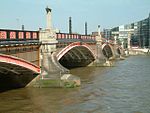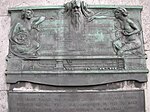London County Council
London County Council | |
|---|---|
Bloc vote | |
Last election | 1961 |
| Meeting place | |
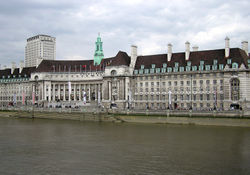 | |
| County Hall, Lambeth | |
The London County Council (LCC) was the principal local government body for the County of London throughout its existence from 1889 to 1965, and the first London-wide general municipal authority to be directly elected. It covered the area today known as Inner London and was replaced by the Greater London Council. The LCC was the largest, most significant and most ambitious English municipal authority of its day.[1]
History

By the 19th century, the
The LCC provided very few services within the City of London, where the ancient Corporation monopolised local governance.[4]
Powers and duties
The LCC inherited the powers of its predecessor the MBW, but had wider authority over matters such as education,
From 1899, the Council progressively acquired and operated the tramways in the county, which it electrified from 1903. By 1933, when the LCC Tramways were taken over by the London Passenger Transport Board, it was the largest tram operator in the United Kingdom, with more than 167 miles (269 km) of route and over 1,700 tramcars.
Housing reform
One of the LCC's most important roles during the late 19th and early 20th century, was in the management of the expanding city and the re-development of its growing slums.[5] In the Victorian era, new housing had been intentionally urban and large-scale tenement buildings dominated. Beginning in the 1930s, the LCC incentivised an increase in more suburban housing styles. A less-dense style of development, focusing on single family homes, was popular among London housing developers because it was believed that this would satisfy the working classes and provide insurance, "against Bolshevism," to quote one parliamentary secretary. The LCC set the standard for new construction at 12 houses per acre of land at a time when some London areas had as many as 80 housing units per acre. The passage of the Housing of the Working Classes Act in 1885 gave the LCC the power to compel the sale of land for housing development, a power that was vital to the systematic rehousing that began under the council's early Progressive leadership.[5]
The Totterdown Fields development at Tooting was the first large suburban-style development to be built under LCC authority, in 1903, and was quickly followed by developments at Roehampton, Bellingham, and Becontree. By 1938, 76,877 units of housing had been built under the auspices of the LCC in the city and its periphery, an astonishing number given the previous pace of development.[6] Many of these new housing developments were genuinely working-class, though the poorest could rarely afford even subsidised rents. They relied on an expanding London Underground network that ferried workers en masse to places of employment in central London. These housing developments were broadly successful, and they resisted the slummification that blighted so many Victorian tenement developments. The success of these commuter developments constructed by the LCC in the periphery of the city is, "one of the more remarkable achievements in London government, and contributed much to the marked improvement of conditions between the wars for the capital's working classes."[5]
The LCC also built overspill estates outside London (some after World War II)[7] including Debden in Essex, Merstham and Sheerwater in Surrey, and Edenbridge in Kent.
Street renaming
The MBW, and the LCC undertook between 1857 and 1945 to standardise and clarify street names across London. Many streets in different areas of the city had similar or identical names, and the rise of the car as a primary mode of transportation in the city sometimes made the duplication of names challenging. In an extreme case, there were over 60 streets called "Cross Street" spread across London when the LCC began its process of systematic renaming. These were given names from an approved list that was maintained by the LCC, containing only "suitably English" names. If street names were deemed un-English, they were also slated for change; Zulu Crescent in Battersea, for instance, became Rowena Crescent in 1912.[8]
Second World War era
By 1939, the council had the following powers and duties:[9]
| Category | Powers and duties | Notes | |
|---|---|---|---|
| Public Assistance |
|
Many of these powers were acquired in 1930 when the Local Government Act 1929 abolished the Metropolitan Asylums Board and the Poor Law Boards of Guardians. |
|
| Health Services, Housing and Sanitation |
|
Medical and ambulance services passed to the National Health Service in 1948. | |
| Regulation and Licensing |
|
||
| Protective Services |
|
||
| Education and Museums |
|
The council received powers to provide technical education in 1892. On the abolition of the local education authority with responsibility for elementary and secondary schools on 1 May 1904.
| |
| Transport |
|
Until 1933 the council provided a network of tramway services in the county. This passed to the London Passenger Transport Board. |
† Denotes a power administered by the City of London Corporation within the City.
Headquarters
Spring Gardens
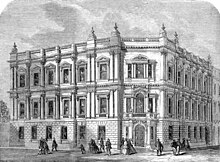
The LCC initially used the
Search for a new site
By 1893, it was clear that the Spring Gardens building was too small for the increased work of the LCC. Seven additional buildings within a quarter of a mile of the County Hall had been acquired, and it was estimated that they would need to take over an average of two more houses annually.
The matter remained unresolved, and in 1900 a special committee was formed by the council to seek out a suitable site. In July 1902, they presented their report, recommending a 3.35-acre (13,600 m2) site in the Adelphi. Entry roads to the proposed county hall would be made from The Strand and The Embankment.[14] The council rejected the recommendations in October 1902, and a suggestion was made that the committee seek a site south of the Thames, adjacent to Westminster Bridge.[15]
County Hall, Lambeth

In April 1905, the council finally agreed to seek powers to buy three adjoining plots of land on the eastern side of Westminster Bridge as a site for a single headquarters. The debate in the council chamber was somewhat heated with one councillor objecting to the purchase as it was "on the wrong side of the river ... in a very squalid neighbourhood ... and quite unworthy of the dignity of a body like the council". Leading member of the council, John Burns countered that it "would brighten up a dull place, sweeten a sour spot and for the first time bring the south of London into a dignified and beautiful frontage on the River Thames."[16]
The necessary powers were obtained under the London County Council (Money) Act 1906, and a competition to design the new building was organised.[17] There were approximately 100 entries, and the winner was the 29-year-old Ralph Knott. Construction began in 1911, and the first section was opened in 1922, with the original building completed in 1933. Extensions continued to be made throughout the council's existence.[11][18]
Politics
Elections
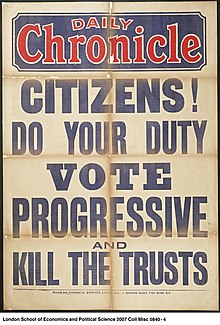
The county was divided into
Complementing the elected councillors and of equal power but longer tenure the council appointed one county alderman for every six councillors. These were elected by halves (as to half of their number) by the council for a six-year term at the first meeting after each election.
Control
Initially, it had been hoped by many that elections to the LCC would be conducted on a non-partisan basis, but in the council two political groups formed. The majority group in 1889 was the Progressives,[21] who were unofficially allied with the Liberal Party in national politics. Those who allied with the Conservative Party formed the Moderate group. In 1906, the Moderates became known as the Municipal Reform Party.
The LCC was elected every three years. The Progressives were in control continuously from 1889 until 1907, when they lost power to the Municipal Reformers. Municipal Reform control lasted until 1934 when Labour won power, which they kept until the LCC was abolished.
Council composition:[22]
| Election | Overall control | Mod./M.R./ Cons. |
Labour | Prog./Lib. | Others |
|---|---|---|---|---|---|
| 1961 | Labour | 42 + 7 | 84 +14 | – | – |
| 1958 | Labour | 25 + 7 | 101 + 14 | – | – |
| 1955 | Labour | 52 + 8 | 74 + 13 | – | – |
| 1952 | Labour | 37 + 6 | 92 + 15 | – | – |
| 1949 | Labour | 64 + 5 | 64 + 16 | 1 + 0 | – |
| 1946 | Labour | 30 + 6 | 90 + 14 | 2 + 0 | 2 + 0 |
| 1937 | Labour | 49 + 8 | 75 + 12 | – | – |
| 1934 | Labour | 55 + 9 | 69 + 11 | – | – |
| 1931 | Municipal Reform | 83 + 13 | 35 + 6 | 6 + 0 | 0 + 1 |
| 1928 | Municipal Reform | 77 + 12 | 42 + 6 | 5 + 1 | 0 + 1 |
| 1925 | Municipal Reform | 83 + 13 | 35 + 6 | 6 + 0 | – |
| 1922 | Municipal Reform | 82 + 12 | 16 + 3 | 26 + 5 | – |
| 1919 | Municipal Reform | 68 + 12 | 15 + 2 | 40 + 6 | 1 + 0 |
| 1913 | Municipal Reform | 67 + 15 | 2 + 0 | 49 + 4 | – |
| 1910 | Municipal Reform | 60 + 17 | 3 + 0 | 55 + 2 | – |
| 1907 | Municipal Reform | 79 + 11 | 1 + 0 | 37 + 8 | 1 + 0 |
| 1904 | Progressive | 35 + 6 | – | 82 + 13 | 1 + 0 |
| 1901 | Progressive | 32 + 6 | 0 + 1 | 86 + 12 | – |
| 1898 | Progressive | 48 + 8 | 0 + 1 | 70 + 10 | – |
| 1895 | Progressive | 59 + 7 | – | 59 + 12 | – |
| 1892 | Progressive | 35 + 2 | – | 83 + 17 | – |
| 1889 | Progressive | 46 + 1 | – | 72 + 18 | – |
Leaders

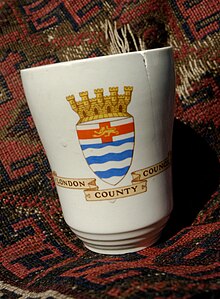
The post of
| Name | Party | From | To | Years served | |
|---|---|---|---|---|---|
| Thomas Farrer | Progressive | 21 Mar 1889 | 27 Mar 1890 | 1 | |
| James Stuart | Progressive | 27 Mar 1890 | 9 Mar 1892 | 2 | |
| Charles Harrison | Progressive | 9 Mar 1892 | 10 Mar 1898 | 6 | |
| Thomas McKinnon Wood | Progressive | 10 Mar 1898 | 8 Mar 1907 | 9 | |
| Richard Robinson | Municipal Reform | 8 Mar 1907 | 11 Mar 1908 | 1 | |
| William Peel | Municipal Reform | 11 Mar 1908 | 8 Mar 1910 | 2 | |
William Hayes Fisher |
Municipal Reform | 8 Mar 1910 | 19 Dec 1911 | 1¾ | |
| Cyril Jackson | Municipal Reform | 19 Dec 1911 | 16 Mar 1915 | 4¼ | |
| Ronald Collet Norman | Municipal Reform | 16 Mar 1915 | 1 Mar 1918 | 3 | |
| George Hume | Municipal Reform | 1 Mar 1918 | 11 Mar 1925 | 7 | |
| William Ray | Municipal Reform | 11 Mar 1925 | 9 Mar 1934 | 9 | |
| Herbert Morrison | Labour | 9 Mar 1934 | 27 May 1940 | 6.16 | |
| Charles Latham | Labour | 27 May 1940 | 29 Jul 1947 | 7.16 | |
| Isaac Hayward | Labour | 29 Jul 1947 | 31 Mar 1965 | 17¾ | |
Chairmen and vice chairmen

The county council was required by statute to appoint a chairman and a vice chairman at its annual meeting. Both of these positions were generally filled by members of the majority party. The chairman chaired meetings of the council, and was the county's civic leader, filling a similar role to the mayor of a borough or city. The vice chairman performed these functions in his absence. The first chairman was the Earl of Rosebery, and the last chairman was Arthur Wicks.
The chairmanship was a prestigious office, second only to that of
Deputies
The council's
Abolition

After World War II, it became evident that the London County Council was too small to cope with the greater demands being placed on local government by the new Welfare State.[29] In 1957, a Royal Commission on Local Government in Greater London was set up under Sir Edwin Herbert to examine the issues and make recommendations. The Commission deliberated for three years and in 1960 it recommended a major restructuring of local government in London. This included the abolition of all existing local authorities with the exception of the City of London Corporation; a Greater London Council was to be established along with 32 new lower-tier London boroughs with populations of 100,000 to 250,000 each. The new boroughs would split the responsibility for government functions with the Greater London Council.[30]
The Royal Commission's report led to the Bill for the London Government Act 1963,[31] and when this was introduced into Parliament it initially faced considerable opposition.[32][33][34] The Bill passed into law with some minor amendments. An Inner London Education Authority was set up for education to be overseen on a broad county level. The first elections for the new Greater London Council were held on 9 April 1964. The London County Council ran concurrently for a year with the new Greater London Council to ensure a seamless transition, and the LCC was finally abolished on 1 April 1965. The Royal Commission commented that "nobody studying London Government can fail to be deeply impressed with the achievements of the London County Council. It has given the Administrative County of London a strong and able form of government which makes its standing very high among the municipal governments of the world."[30]
See also
- History of local government in London
- Coat of arms of London County Council
- London County Council Staff Association
- London County Council Tramways
- List of members of London County Council 1889–1919
- List of members of London County Council 1919–1937
- List of members of London County Council 1937–1949
- London Metropolitan Archives
References
- ^ Saint, A. (1989). Politics and the people of London: the London County Council (1889–1965).
- ^ Szreter, Simon (May 2002). "A central role for local government? The example of late Victorian Britain". History & Policy. History & Policy. Archived from the original on 17 December 2013. Retrieved 9 December 2010.
- ^ Albert Emil Davies (1937). The London County Council 1889–1931: A Historical Sketch. Fabian Society.
- OCLC 504395625.
- ^ a b c Roy Porter (1994). London: A Social History. Harvard University Press.
- ^ W. Ashworth (1954). The Genesis of Modern British Town Planning: A Study in Economic and Social History of the Nineteenth and Twentieth Centuries. Routledge.
- ^ Municipal Dreams
- ^ "Old and New Street Names". History & Policy. The Hunt House London. December 2015. Retrieved 7 December 2015.
- ^ "Powers and Duties of the L.C.C.". The Times. 21 March 1939. p. vi.
- ^ a b c "Old County Hall (including site of Berkeley House)". Survey of London: volume 20: St Martin-in-the-Fields, pt III: Trafalgar Square & Neighbourhood. British History Online. 1940. Retrieved 21 August 2009.
- ^ a b c "Homes of the Council. Spring Gardens and County Hall". The Times. 21 March 1939. p. vi.
- ^ a b c "The London County Council". The Times. 15 July 1893. pp. 13–14.
- ^ "Proposed London County Council Buildings". The Times. 28 June 1893. p. 4.
- ^ "Proposed New London County Hall". The Times. 21 July 1902. p. 3.
- ^ "London County Hall". The Times. 22 October 1902. p. 10.
- ^ "London County Council. The New County Hall". The Times. 19 April 1905. p. 12.
- ^ "London County Council (Money) Bill". Parliamentary Debates (Hansard). 9 July 1906. Retrieved 21 August 2009.
- ^ Pevsner, Nikolaus (1952). London except the Cities of London and Westminster. The Buildings of England. Penguin. p. 274.
- ^ Local Government Act 1888, S.40(4)
- ^ Representation of the People Act 1948, chapter (statute number) 65, section 59
- ISBN 0750921587.
- ISBN 1-85285-029-9.
- ^ "The Coronation Honours". The Times. 26 June 1902. p. 5.
- ^ "No. 28589". The London Gazette. 12 March 1912. p. 1827.
- ^ "L.C.C. Chairman Knighted". The Times. 7 July 1953. p. 6.
- ^ "Royal Guests of L.C.C. The Queen At The County Hall, Honour For Chairman". The Times. 1 June 1935. p. 16.
- ^ "London Amalgamation – The Commissioners' Report". The Times. 1 October 1894. pp. 13–14.
- ^ "The London County Council Clerkship". The Times. 14 December 1895. p. 5.
- ^ London County Council – 'Exploring 20th Century London
- ^ a b London County Council – London Metropolitan Archives Collections Catalogue – City of London website
- ^ "London Government Act 1963". Retrieved 10 July 2023.
- ^ "LOCAL GOVERNMENT BILL". Parliamentary Debates (Hansard). House of Lords. 14 March 1962. col. 278–291.
- ^ "LOCAL GOVERNMENT BILL". Parliamentary Debates (Hansard). House of Commons. 20 February 1963. col. 278–518.
- ^ "LOCAL GOVERNMENT BILL". Parliamentary Debates (Hansard). House of Commons. 11 December 1962. col. 278–291.
External links
![]() Media related to London County Council at Wikimedia Commons
Media related to London County Council at Wikimedia Commons


